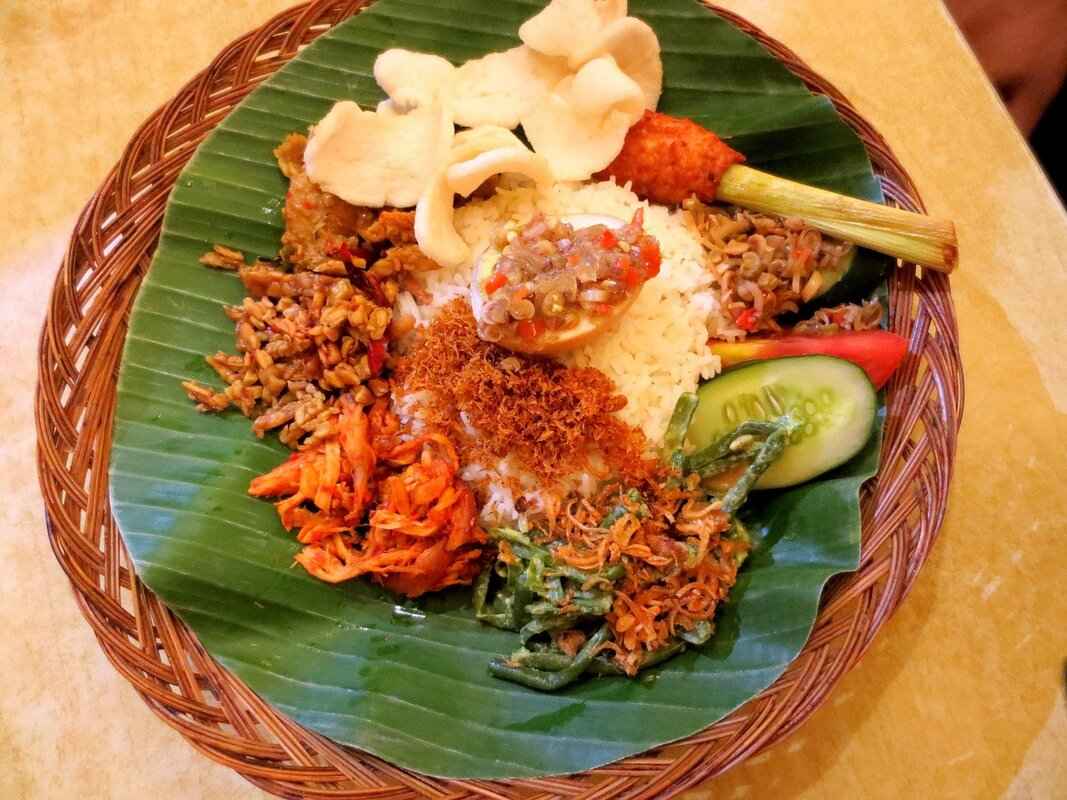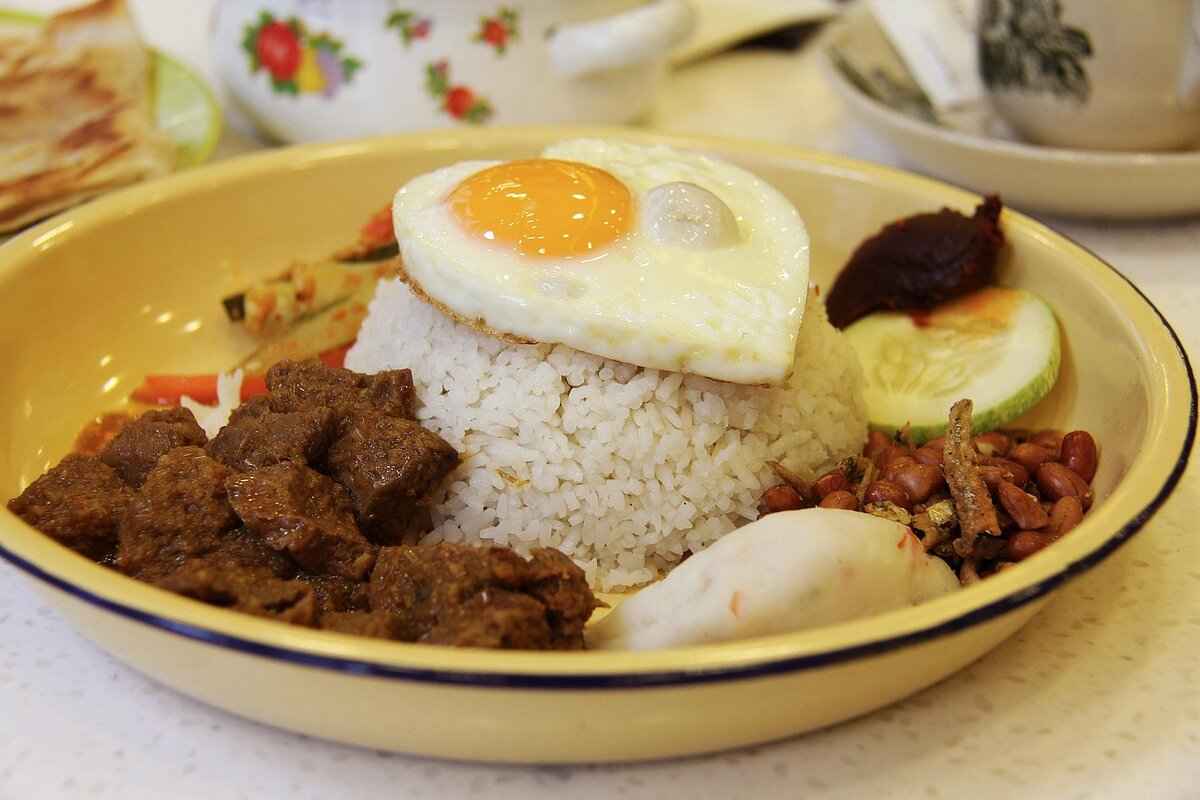Malaysia is a vibrant tapestry of cultures, and its culinary heritage reflects this diversity. This article delves into the rich culinary landscape of Malaysia, highlighting iconic dishes such as Nasi Lemak and Laksa. We will explore their history, essential ingredients, and the cultural significance that makes them beloved staples in Malaysian cuisine.
Nasi Lemak is often hailed as Malaysia’s national dish, celebrated for its fragrant rice cooked in coconut milk. Its origins can be traced back to the Malay community, where it was traditionally consumed as a breakfast dish. Over the years, it has evolved into a symbol of Malaysian identity. The dish typically features a combination of rice, sambal (spicy chili paste), fried anchovies, peanuts, and boiled eggs, each component contributing to its unique flavor profile.
- Fragrant Rice: The rice is cooked in coconut milk, giving it a creamy texture and a rich aroma.
- Sambal: This spicy condiment is essential, providing heat and depth to the dish.
- Fried Anchovies: Crispy and salty, they add a delightful crunch.
- Peanuts: Roasted peanuts offer a nutty flavor and additional texture.
- Boiled Eggs: They provide protein and balance the spiciness of the sambal.
Each ingredient plays a pivotal role in creating the harmonious blend of flavors that define Nasi Lemak.
Making authentic Nasi Lemak at home is an enriching experience. Start by rinsing the rice and soaking it for about 30 minutes. Then, cook it in coconut milk with a pinch of salt for an aromatic finish. While the rice cooks, prepare the sambal by frying onions, garlic, and chili paste until fragrant. Assemble the dish by serving the rice with sambal, fried anchovies, peanuts, and a boiled egg. For an authentic touch, consider adding cucumber slices and a piece of fried chicken.
Mastering the cooking techniques is crucial for perfecting Nasi Lemak. Soaking the rice helps achieve the right texture, while frying the sambal until it releases its oils enhances the flavors. The balance of spices in the sambal is essential for a delicious outcome, so feel free to adjust the heat level according to your preference.
Nasi Lemak can be served in various ways, from a simple plate to a more elaborate meal. Consider pairing it with additional sides such as fried chicken, rendang (spicy meat dish), or even a side of curry for a complete feast. Presentation is key; serve it on a banana leaf for an authentic touch or in a bowl for a modern twist.
If you’re looking to indulge in authentic Nasi Lemak, local eateries and food stalls are the best places to start. Renowned spots in Malaysia, such as Nasi Lemak Antarabangsa and Nasi Lemak Wanjo, are famous for their delicious offerings. Even when abroad, many Malaysian restaurants pride themselves on serving this national treasure.
Laksa is a beloved spicy noodle soup that varies significantly across regions in Malaysia. Its rich flavors and aromatic spices make it a culinary treasure. The two primary types are Assam Laksa, known for its sour fish-based broth, and Curry Laksa, which features a creamy coconut milk base. Each variety offers a unique taste experience, showcasing the diversity of Malaysian cuisine.
Assam Laksa is characterized by its tangy fish broth, often garnished with mint, cucumber, and pineapple. In contrast, Curry Laksa is a comforting bowl of noodles submerged in a rich, spicy coconut curry, topped with tofu, shrimp, and bean sprouts. Both types of Laksa are deeply rooted in Malaysian culture, making them a must-try for any food enthusiast.
The distinctive flavors of Laksa come from a blend of spices, fresh herbs, and key ingredients such as rice noodles, coconut milk, and fish or chicken. The use of lemongrass, galangal, and tamarind enhances the soup’s aroma and taste, creating a complex flavor profile that is both comforting and invigorating.
Creating a delicious bowl of Laksa at home is achievable with the right ingredients and techniques. Start by preparing the broth, blending spices and herbs to create a fragrant base. Next, cook the noodles and assemble your bowl with toppings of choice, ensuring to balance the flavors for an authentic experience.
Even experienced cooks can stumble when making Laksa. Common pitfalls include overcooking the noodles or skimping on spices, which can lead to a bland dish. Always taste and adjust seasoning as you go to ensure a flavorful outcome.
The right beverage can enhance your Laksa experience. Traditional drinks such as Teh Tarik (pulled tea) or Bandung (rose syrup drink) complement the dish’s bold flavors, making your meal even more enjoyable.

What is Nasi Lemak and Why is it Iconic?
Nasi Lemak is not just a dish; it is a symbol of Malaysian culture and identity. Renowned as the national dish of Malaysia, Nasi Lemak captures the essence of the country’s diverse culinary heritage. The dish consists of fragrant rice cooked in creamy coconut milk, which creates a rich and aromatic base. Traditionally served on a banana leaf, it is a feast for both the eyes and the palate.
The origins of Nasi Lemak can be traced back to the Malay community, where it was initially a farmers’ meal, providing the necessary energy for long days in the fields. Over the years, it has evolved into a beloved staple enjoyed by people from all walks of life. Its popularity has transcended borders, making it a must-try for anyone visiting Malaysia.
What Makes Nasi Lemak Special? The dish is distinguished by its unique combination of ingredients that work harmoniously to create a balanced flavor profile. Each component serves a purpose:
- Coconut Rice: The heart of Nasi Lemak, this rice is cooked with coconut milk, giving it a rich, creamy texture and a subtle sweetness.
- Sambal: A spicy chili paste that adds heat and depth to the dish. The sambal can vary in flavor and spiciness, often made with ingredients like shrimp paste, garlic, and lime.
- Fried Anchovies: These crunchy bits provide a salty contrast, enhancing the overall taste.
- Peanuts: Roasted peanuts add another layer of crunch and nuttiness.
- Boiled Eggs: Typically served sliced, they add creaminess and richness to the dish.
- Vegetables: Often accompanied by cucumber slices and sometimes fried chicken or rendang, these elements complete the meal.
The beauty of Nasi Lemak lies in its versatility. While the traditional components remain constant, many variations exist, allowing for personal touches and regional influences. Some may include fried chicken, beef rendang, or even seafood, making it a dish that can cater to different tastes and preferences.
Furthermore, Nasi Lemak is not just a meal; it is often enjoyed at any time of the day. Whether as a hearty breakfast, a satisfying lunch, or a late-night snack, it holds a special place in the hearts of Malaysians. The dish’s ability to bring people together, whether at street stalls or family gatherings, is a testament to its cultural significance.
In conclusion, Nasi Lemak is more than just a plate of food; it is a representation of Malaysia’s rich culinary tapestry. Its delightful combination of flavors, textures, and aromas makes it an iconic dish that continues to be cherished by locals and tourists alike. Exploring Nasi Lemak is not just about tasting a meal; it is about experiencing a piece of Malaysian heritage.

Exploring the Ingredients of Nasi Lemak
Nasi Lemak is not just a dish; it’s a culinary experience that embodies the essence of Malaysian culture. At the heart of this beloved national dish lies a harmonious blend of ingredients, each contributing uniquely to its flavor profile. In this section, we will delve into the key components of Nasi Lemak: the rice, sambal, fried anchovies, peanuts, and boiled eggs.
The foundation of Nasi Lemak is its fragrant rice, which is traditionally cooked in rich coconut milk. This method not only infuses the rice with a creamy texture but also provides a subtle sweetness that balances the dish’s savory elements. The rice is often served with a sprinkle of pandan leaves, enhancing its aroma and adding a distinct fragrance that is irresistible.
Sambal is the soul of Nasi Lemak, a spicy chili paste that elevates the dish to new heights. Made from a blend of fresh chilies, garlic, shallots, and sometimes shrimp paste, sambal adds a fiery kick that contrasts beautifully with the creamy rice. The depth of flavor in sambal can vary, with some versions being sweeter and others more pungent, allowing for a personalized taste experience.
Fried anchovies, known as ikan bilis, provide a delightful crunch and a umami flavor that complements the other ingredients. Their salty, crispy texture adds a savory depth, making each bite of Nasi Lemak more satisfying. The anchovies are typically fried until golden brown, enhancing their flavor and making them a perfect topping for the rice.
Peanuts are another essential component of Nasi Lemak, contributing both texture and flavor. Roasted and lightly salted, they add a satisfying crunch that contrasts with the soft rice and creamy sambal. The nuttiness of the peanuts also balances the spiciness of the sambal, creating a well-rounded dish that appeals to a wide range of palates.
Lastly, the addition of boiled eggs offers a creamy richness that enhances the overall flavor profile of Nasi Lemak. Typically sliced in half, the eggs add a luxurious touch to the dish. The yolk can be slightly runny, providing a rich, velvety texture that melds beautifully with the sambal and rice.
The magic of Nasi Lemak lies in the way these ingredients interact. The creamy rice provides a base that absorbs the flavors of the sambal, while the fried anchovies and peanuts add contrasting textures. The boiled eggs introduce a richness that ties everything together, making each bite a delightful experience.
In conclusion, Nasi Lemak is a celebration of flavors and textures, where each ingredient plays a crucial role in creating a dish that is both comforting and exciting. Understanding the significance of each component enhances the appreciation of this iconic Malaysian dish, making it a must-try for anyone exploring the rich culinary landscape of Malaysia.
How to Prepare Authentic Nasi Lemak
Preparing Nasi Lemak at home can be an incredibly rewarding culinary adventure. This beloved Malaysian dish is not only a feast for the taste buds but also a celebration of cultural heritage. In this section, we will guide you through a detailed, step-by-step process to create an authentic Nasi Lemak experience, from cooking the rice to assembling the dish.
Step 1: Cooking the Rice
The foundation of Nasi Lemak is its fragrant rice, which is traditionally cooked in coconut milk to impart a rich flavor. Begin by rinsing 2 cups of jasmine rice under cold water until the water runs clear. This removes excess starch and prevents the rice from becoming sticky. Next, soak the rice for about 30 minutes. This step is crucial as it helps the grains absorb moisture and cook evenly.
- In a pot, combine the soaked rice with 2 cups of coconut milk, 1 cup of water, 1 pandan leaf (tied in a knot), and a pinch of salt.
- Bring the mixture to a boil, then reduce the heat to low, cover, and simmer for about 20 minutes or until the rice is tender and fluffy.
Step 2: Preparing the Sambal
Sambal is the spicy condiment that elevates Nasi Lemak. To prepare sambal, you will need:
- 5 dried red chilies (soaked and seeds removed)
- 3 shallots
- 2 cloves of garlic
- 1 tablespoon of shrimp paste (optional)
- 2 tablespoons of cooking oil
- Salt and sugar to taste
Blend the chilies, shallots, and garlic into a smooth paste. Heat the oil in a pan, add the paste, and fry until aromatic. Stir in the shrimp paste, salt, and sugar, and cook until the sambal thickens. Adjust seasoning as needed.
Step 3: Assembling the Dish
Once you have your rice and sambal ready, it’s time to assemble your Nasi Lemak. Traditionally, it is served with:
- Fried anchovies (ikan bilis)
- Roasted peanuts
- Hard-boiled eggs or fried eggs
- Slices of cucumber
To serve, place a generous scoop of rice on a plate, surrounded by the accompaniments. Top it off with a dollop of sambal for that perfect kick.
Step 4: Enjoying Your Creation
Serving Nasi Lemak is an experience in itself. Traditionally wrapped in banana leaves, it can also be plated beautifully for a more contemporary presentation. Pair your meal with a refreshing glass of teh tarik (pulled tea) or iced coffee for a delightful experience.
With these steps, you can create a delicious and authentic Nasi Lemak that will impress your family and friends. The combination of flavors and textures makes this dish a true Malaysian classic, perfect for any occasion.
Essential Cooking Techniques for Nasi Lemak
When it comes to preparing Nasi Lemak, mastering specific cooking techniques is vital to achieving the authentic flavors that make this dish so beloved. The two fundamental techniques that stand out are soaking the rice and frying the sambal. Let’s delve deeper into why these steps are crucial for perfecting this iconic Malaysian dish.
Why is Soaking Rice Important?
Soaking rice before cooking is a technique that many chefs swear by. This process not only helps to improve the texture of the rice but also enhances its ability to absorb flavors. For Nasi Lemak, using jasmine rice is ideal due to its fragrant aroma and fluffy texture. Here are some benefits of soaking rice:
- Reduces Cooking Time: Soaking rice for at least 30 minutes can significantly cut down the cooking time, allowing for a more efficient preparation process.
- Improves Texture: Soaked rice tends to be less sticky and more separate after cooking, which is essential for serving Nasi Lemak.
- Enhances Flavor Absorption: The soaking process allows the rice to better absorb the coconut milk and other flavors during cooking, resulting in a more aromatic dish.
The Art of Frying Sambal
Sambal is the heart and soul of Nasi Lemak, and frying it correctly can elevate the dish to new heights. The key to a flavorful sambal lies in the balance of ingredients and cooking technique. Here’s how to achieve the perfect sambal:
- Choosing Fresh Ingredients: Use fresh chili peppers, onions, and garlic to create a vibrant sambal. The freshness of the ingredients directly impacts the flavor.
- Cooking at the Right Temperature: Fry sambal over medium heat to allow the flavors to meld together without burning the ingredients. This helps to develop a rich, deep flavor.
- Adding Depth: Incorporate ingredients like belacan (fermented shrimp paste) or tamarind paste to enhance the umami flavor, making your sambal irresistible.
Combining Techniques for the Perfect Nasi Lemak
When both the rice and sambal are prepared with care, the result is a Nasi Lemak that is not only delicious but also visually appealing. The fluffy, coconut-infused rice pairs perfectly with the spicy sambal, creating a harmonious balance of flavors. Additionally, serving Nasi Lemak with traditional accompaniments such as fried anchovies, peanuts, and boiled eggs adds layers of texture and taste.
In conclusion, the essential cooking techniques of soaking rice and frying sambal are crucial steps in perfecting Nasi Lemak. By understanding and applying these methods, anyone can create an authentic and flavorful dish that pays homage to Malaysia’s rich culinary heritage.
Serving Suggestions for Nasi Lemak
Nasi Lemak, often regarded as Malaysia’s national dish, is not just a meal but a cultural experience. Its versatility allows it to be served in numerous ways, each enhancing its delightful flavors. This section delves into some popular accompaniments and presentation styles that elevate the dining experience of Nasi Lemak.
- Traditional Accompaniments: The classic Nasi Lemak is typically served with a variety of side dishes. The most common include sambal, a spicy chili paste that adds a fiery kick, along with fried anchovies, roasted peanuts, and sliced cucumbers. These elements not only complement the rich coconut rice but also provide a balance of textures and flavors.
- Protein Options: While boiled eggs are a staple, many enjoy adding fried chicken, rendang (a slow-cooked beef dish), or even grilled fish. These proteins enhance the dish, making it more filling and satisfying. Each option brings its own unique flavor profile, allowing for a personalized touch.
- Vegetarian Variations: For those seeking a vegetarian twist, Nasi Lemak can be paired with a variety of plant-based sides. Consider adding tofu cooked in sambal or a medley of stir-fried vegetables. These alternatives retain the essence of Nasi Lemak while catering to diverse dietary preferences.
- Garnishes and Extras: Presentation plays a crucial role in the dining experience. A sprinkle of fried shallots or a dash of fresh herbs like coriander can elevate the dish visually and add layers of flavor. Additionally, serving Nasi Lemak on a banana leaf not only enhances its aesthetic appeal but also infuses a subtle aroma.
When it comes to serving Nasi Lemak, the presentation can vary widely, from casual street-side stalls to upscale restaurants. In many traditional settings, the dish is served on a plate lined with banana leaves, creating an authentic feel. Alternatively, some modern eateries opt for elegant plating, showcasing the vibrant colors of the ingredients.
Moreover, pairing Nasi Lemak with beverages can significantly enhance the meal. Traditional drinks like teh tarik (pulled tea) or milo ais (iced chocolate malt drink) complement the dish perfectly, balancing the spiciness of sambal with their sweetness.
In conclusion, the serving suggestions for Nasi Lemak are as diverse as the dish itself. By exploring various accompaniments and presentation styles, one can truly appreciate the complexity and richness of this beloved Malaysian dish. Whether enjoyed at home or in a bustling food market, Nasi Lemak offers a delightful culinary journey that reflects Malaysia’s vibrant culture.
Where to Find the Best Nasi Lemak
Whether you’re in Malaysia or exploring the culinary scene abroad, locating authentic Nasi Lemak is essential for any food lover. This beloved dish, often regarded as Malaysia’s national treasure, is not just a meal but a cultural experience. To ensure you savor the most genuine flavors, here are some renowned eateries and food stalls that serve exceptional Nasi Lemak.
- Village Park Restaurant, Damansara Uptown: Renowned for its rich and fragrant Nasi Lemak, this restaurant is a must-visit. The dish is served with crispy fried chicken and a generous helping of sambal that packs a punch.
- Nasi Lemak Antarabangsa, Kampung Baru: Located in the heart of Kuala Lumpur, this establishment is famous for its traditional approach. The coconut rice is perfectly cooked, and the sambal here is a delightful blend of spicy and sweet.
- Warung Nasi Lemak, Penang: This humble food stall offers a unique twist on the classic dish. Their Nasi Lemak is accompanied by a variety of side dishes, including rendang and fried squid, making it a local favorite.
- Hameediyah Restaurant, George Town: Known for its rich history and authentic flavors, Hameediyah serves Nasi Lemak with a side of curry that elevates the dish to new heights. The combination of spices is a testament to Penang’s diverse culinary heritage.
- Roti Canai Transfer Road, Penang: While primarily known for its roti canai, this spot also serves a fantastic Nasi Lemak. The combination of crispy anchovies and creamy coconut rice is simply irresistible.
In addition to these popular spots, many local food stalls across Malaysia offer hidden gems. Keep an eye out for street vendors who serve Nasi Lemak wrapped in banana leaves, a traditional presentation that enhances the dish’s aroma and flavor.
If you’re outside Malaysia, don’t worry! Many Malaysian restaurants around the world strive to replicate the authentic taste of Nasi Lemak. Look for establishments that emphasize traditional cooking methods and use quality ingredients. Online reviews and food blogs can also guide you to the best options available in your area.
When searching for the perfect Nasi Lemak, consider the following tips:
- Look for places with a long queue; this often indicates the quality and popularity of the food.
- Ask locals for recommendations; they can point you to hidden treasures that might not be well-known to tourists.
- Try different variations of Nasi Lemak, as each region in Malaysia has its own unique twist on this classic dish.
In conclusion, whether you’re indulging in Nasi Lemak at a bustling restaurant in Malaysia or a cozy corner of a Malaysian eatery abroad, the experience is sure to be memorable. Embrace the flavors, textures, and aromas that make Nasi Lemak a beloved dish across cultures. Happy eating!

What Makes Laksa a Must-Try Dish?
Laksa is not just a dish; it is a culinary experience that embodies the vibrant flavors of Southeast Asia. This spicy noodle soup has captured the hearts and palates of many, thanks to its rich history and diverse regional variations. As we explore what makes Laksa a must-try dish, we will delve into its origins, the different types, and the unique ingredients that contribute to its status as a culinary treasure.
Originating from the Peranakan culture, Laksa reflects the fusion of Chinese and Malay culinary traditions. It is believed to have emerged in the 15th century, with its roots deeply embedded in the coastal regions of Malaysia and Singapore. The dish has evolved over time, leading to various interpretations that highlight local ingredients and flavors.
- Assam Laksa: A tangy fish-based soup, often made with mackerel and flavored with tamarind, mint, and lemongrass. Its distinct sourness makes it a favorite among many.
- Curry Laksa: A creamy coconut milk soup that is rich and aromatic, typically featuring chicken or shrimp, and garnished with bean sprouts and boiled eggs.
- Laksa Lemak: A variation of Curry Laksa, known for its thicker broth and a more pronounced coconut flavor, often served with rice noodles.
The magic of Laksa lies in its diverse ingredients. Common elements include:
- Noodles: Rice vermicelli or thick rice noodles serve as the base.
- Broth: A flavorful concoction made from spices, herbs, and either fish or meat.
- Spices: A blend of chili, turmeric, and ginger contributes to the dish’s signature heat and aroma.
- Garnishes: Fresh herbs, such as cilantro and mint, along with lime wedges, enhance the dish’s freshness.
Creating an authentic bowl of Laksa at home is easier than you might think. Start by preparing the broth, which involves simmering your choice of meat or fish with spices and aromatics. Next, cook the noodles according to package instructions. Finally, assemble the dish by combining the broth, noodles, and garnishes. For a detailed recipe, consider the following steps:
1. Prepare the broth: Sauté spices and aromatics, add stock, and simmer.2. Cook the noodles: Boil until tender, then drain.3. Assemble: In a bowl, place noodles, pour over broth, and garnish.
Even seasoned cooks can stumble when making Laksa. Here are some common pitfalls to avoid:
- Using low-quality ingredients can compromise flavor.
- Overcooking the noodles may lead to a mushy texture.
- Neglecting to balance the flavors can result in a bland dish.
The right beverage can elevate your Laksa experience. Traditional pairings include:
- Teh Tarik: A frothy pulled tea that complements the dish’s spiciness.
- Chrysanthemum Tea: A floral drink that refreshes the palate.
In conclusion, Laksa is a dish that represents the rich tapestry of Malaysian cuisine. Its diverse varieties, unique ingredients, and the cultural stories behind them make it a must-try for anyone looking to explore the flavors of Southeast Asia.
Understanding the Different Types of Laksa
When it comes to Malaysian cuisine, Laksa stands out as a beloved dish that showcases the country’s rich culinary diversity. This spicy noodle soup comes in various regional varieties, each with its own unique flavor profile and ingredients. In this section, we will delve into the different types of Laksa, highlighting their key differences and the distinct taste experiences they offer.
Assam Laksa is a sour fish-based noodle soup that hails from the Penang region. The broth is made from mackerel, which is cooked and then shredded to create a flavorful base. The soup is characterized by its tangy flavor, thanks to the addition of tamarind and a blend of spices. Served with thick rice noodles, Assam Laksa is garnished with fresh ingredients such as cucumber, pineapple, and mint, contributing to its refreshing taste.
Curry Laksa, on the other hand, is a coconut milk-based soup that offers a rich and creamy texture. This version is commonly found in the Peranakan culture and is typically made with chicken, prawns, or tofu. The broth is infused with a variety of spices, including lemongrass, galangal, and curry powder, giving it a distinct aroma and flavor. Served with thin rice vermicelli, Curry Laksa is often topped with bean sprouts, boiled eggs, and fried tofu puffs, making it a hearty meal.
While both Assam Laksa and Curry Laksa are delicious, they offer vastly different taste experiences. Assam Laksa is known for its spicy and sour notes, making it a refreshing option, especially on hot days. In contrast, Curry Laksa is celebrated for its richness and creaminess, appealing to those who enjoy a more indulgent dish. The choice between the two often comes down to personal preference, as both types have their own loyal fan base.
Beyond Assam and Curry Laksa, there are numerous regional variations that further enrich the Laksa family. For instance, Laksa Lemak is a variation of Curry Laksa that is particularly popular in Singapore and is often richer due to the use of more coconut milk. Meanwhile, Penang Laksa is a variant of Assam Laksa that emphasizes the use of local ingredients, resulting in a unique blend of flavors.
Both Assam and Curry Laksa can be nutritious options, depending on the ingredients used. The inclusion of fresh vegetables and herbs not only enhances the flavor but also adds vitamins and minerals to the dish. Additionally, the fish used in Assam Laksa provides a good source of omega-3 fatty acids, while the spices in Curry Laksa can boost metabolism and have anti-inflammatory properties.
When enjoying Laksa, it is common to pair it with traditional side dishes such as roti canai or fried tofu. These accompaniments complement the flavors of the soup and provide a satisfying meal. Whether you prefer the tangy Assam Laksa or the creamy Curry Laksa, both dishes offer a delightful culinary experience that is emblematic of Malaysia’s rich food culture.
Key Ingredients in Laksa
Laksa is a beloved dish that showcases the rich culinary diversity of Malaysia. Its vibrant and complex flavors stem from a variety of ingredients that come together to create a truly unique experience. In this section, we will delve into the key ingredients that give Laksa its signature taste, exploring the roles of spices, noodles, and garnishes.
The heart of Laksa lies in its bold and aromatic spices. A typical Laksa broth is infused with a blend of spices that can include:
- Chili peppers – These provide the essential heat that Laksa is known for.
- Lemongrass – Adds a citrusy note that brightens the dish.
- Galangal – A root similar to ginger, it imparts a unique flavor profile.
- Turmeric – Gives the broth its vibrant yellow color and earthy flavor.
- Coriander – Adds a fresh, herbal quality that balances the spices.
These spices not only enhance the taste but also contribute to the overall aroma, making Laksa a feast for the senses.
Noodles are another essential component of Laksa, providing a hearty base for the dish. The type of noodles used can vary by region:
- Rice vermicelli – Commonly used in Curry Laksa, these thin noodles absorb the rich broth beautifully.
- Thick rice noodles – Often found in Assam Laksa, they offer a chewy texture that complements the soup.
- Egg noodles – Sometimes included in variations, these add a different flavor and texture.
The choice of noodles can significantly affect the overall experience of the dish, making it crucial to select the right type for your recipe.
No bowl of Laksa is complete without its signature garnishes. These not only add visual appeal but also layers of flavor:
- Bean sprouts – Provide a crunchy texture that contrasts with the smooth broth.
- Hard-boiled eggs – A common addition that adds richness and protein.
- Fresh herbs – Typically, mint or cilantro are used to brighten the dish.
- Lime wedges – A squeeze of lime adds acidity, balancing the richness of the broth.
These garnishes elevate the dish, making each spoonful a delightful mix of flavors and textures.
Using fresh ingredients is crucial for achieving the authentic taste of Laksa. Fresh herbs and spices can significantly enhance the flavor profile, bringing out the vibrant notes that are characteristic of this dish. Moreover, fresh noodles can provide the ideal texture, ensuring that the dish is satisfying and delicious.
In conclusion, the key ingredients of Laksa—spices, noodles, and garnishes—come together to create a dish that is not only rich in flavor but also deeply rooted in Malaysian culture. Understanding these components allows you to appreciate the culinary artistry behind Laksa and perhaps inspire you to create your own version at home.

How to Make Laksa at Home
Creating a delicious bowl of Laksa at home can be simple and rewarding. This popular Malaysian dish is not only packed with flavor but also offers a delightful culinary experience. In this section, we will provide a comprehensive recipe along with essential tips for perfecting your Laksa.
Ingredients You’ll Need
- Noodles: Choose between rice noodles or egg noodles based on your preference.
- Broth: Use chicken or seafood stock as a base for your Laksa.
- Spices: Essential spices include lemongrass, galangal, turmeric, and chili paste.
- Protein: Common choices are shrimp, chicken, or tofu for a vegetarian option.
- Garnishes: Fresh herbs like cilantro, mint, and sliced lime add a refreshing touch.
Step-by-Step Recipe
1. Start by preparing the Laksa paste. Blend together lemongrass, galangal, turmeric, and chili paste until smooth.2. In a pot, heat some oil and sauté the Laksa paste for about 2-3 minutes until fragrant.3. Add your choice of stock and bring to a boil. Let it simmer for 10 minutes, allowing the flavors to meld.4. Add in your protein and cook until fully done.5. Meanwhile, cook your noodles according to package instructions and set aside.6. To serve, place the cooked noodles in bowls, pour the hot broth over them, and garnish with fresh herbs and lime.
Tips for Perfecting Your Laksa
- Balance the Flavors: Ensure a good balance of spicy, sour, and savory notes in your broth.
- Fresh Ingredients: Use fresh herbs and spices for the best flavor.
- Customize Your Dish: Feel free to add vegetables like bean sprouts or bok choy for added texture.
Common Mistakes to Avoid
- Using stale spices can dull the flavor of your Laksa.
- Overcooking the noodles can lead to a mushy texture.
- Neglecting to taste and adjust seasoning can result in an unbalanced dish.
Pairing Drinks with Laksa
The right beverage can enhance your Laksa experience. Consider pairing it with a refreshing iced lime juice or a traditional teh tarik (pulled tea) to complement the dish’s bold flavors.
By following this guide, you can create a delicious and authentic Laksa right in your kitchen. Enjoy the rich flavors and the satisfaction of mastering this iconic Malaysian dish!
Common Mistakes to Avoid When Making Laksa
Making Laksa at home can be an exciting culinary adventure, but even experienced cooks can encounter challenges. To ensure that your Laksa is both flavorful and authentic, it is essential to be aware of common mistakes that could compromise your dish. Below, we outline several pitfalls to avoid, along with tips to enhance your cooking experience.
- Using the Wrong Type of Noodles: Different types of Laksa call for specific noodles. For instance, Assam Laksa typically uses thick rice noodles, while Curry Laksa is best with egg noodles. Always check the recipe to ensure you are using the correct noodle type for your chosen Laksa.
- Neglecting the Broth: The broth is the heart of Laksa. A common mistake is not allowing the broth to simmer long enough. This step is crucial for developing rich flavors. Take your time to let the spices meld together, creating a robust base for your dish.
- Overcooking the Ingredients: When adding ingredients like prawns or tofu to your Laksa, be careful not to overcook them. This can lead to a rubbery texture that detracts from the overall experience. Aim for perfectly cooked proteins that complement the dish.
- Ignoring Fresh Herbs: Fresh herbs such as cilantro and mint are essential for garnishing Laksa. Skipping this step can result in a less vibrant flavor. Always finish your dish with a generous sprinkle of fresh herbs for that authentic touch.
- Using Low-Quality Ingredients: The quality of your ingredients greatly impacts the final outcome. Using fresh spices, high-quality coconut milk, and fresh seafood will elevate your Laksa. Avoid pre-packaged or low-quality alternatives that may compromise the dish’s integrity.
- Not Balancing Flavors: Laksa is known for its complex flavors, so it’s important to balance spicy, sour, and sweet elements. Taste as you go and adjust the seasoning with lime juice, sugar, or chili paste to achieve the desired balance.
- Rushing the Cooking Process: Good Laksa takes time. Rushing through the cooking process can lead to underdeveloped flavors. Allow yourself enough time to prepare each component properly, from the broth to the toppings.
- Skipping the Tasting Step: Always taste your broth before serving. This final check allows you to adjust seasonings and ensure that the flavors are just right. Don’t be afraid to tweak the recipe to suit your personal preference.
By being mindful of these common mistakes, you can create a bowl of Laksa that is not only delicious but also a true reflection of this beloved Malaysian dish. Remember, cooking is an art that requires practice, so don’t be discouraged by initial setbacks. Enjoy the process and savor the delightful flavors of your homemade Laksa!
Pairing Drinks with Laksa
When it comes to enjoying a bowl of Laksa, the experience can be elevated significantly by pairing it with the right beverage. The rich, spicy flavors of Laksa call for drinks that can either complement or contrast its boldness, enhancing your overall dining experience. Below, we explore some traditional beverage options that are perfect for pairing with this iconic Malaysian dish.
- Teh Tarik: This popular Malaysian milk tea is known for its frothy top and sweet, creamy flavor. The combination of tea and condensed milk provides a refreshing contrast to the spiciness of Laksa, making it a perfect companion.
- Bandung: Made from rose syrup and milk, Bandung offers a sweet and floral flavor profile. Its creamy texture and sweetness can help balance the heat from the Laksa, providing a delightful contrast.
- Fresh Coconut Water: For a more natural option, fresh coconut water is an excellent choice. Its light, refreshing taste hydrates and cleanses the palate, allowing you to fully enjoy the complex flavors of Laksa.
- Ginger Tea: A warm cup of ginger tea can be a soothing accompaniment to Laksa. The spiciness of ginger complements the dish while also aiding digestion, making it a thoughtful pairing.
- Fruit Juices: Juices such as lime or pineapple can add a zesty freshness that cuts through the richness of the Laksa. A splash of citrus can brighten the meal, enhancing the overall flavor experience.
Pairing drinks with your meal is not just about quenching your thirst; it’s about enhancing the flavors and textures of the food. The right beverage can amplify the taste sensations of Laksa, creating a more satisfying meal. For example, the sweetness of Teh Tarik can soften the heat of the curry, while the acidity of fruit juices can provide a refreshing counterpoint.
When selecting a drink to accompany your Laksa, consider the following:
- Spice Level: If your Laksa is particularly spicy, opt for a drink that has a cooling effect, such as coconut water or milk-based beverages.
- Flavor Profile: Think about the flavors present in your Laksa. If it has a strong curry flavor, a drink with citrus notes can help balance it out.
- Personal Preference: Ultimately, your choice should reflect your personal taste. Experiment with different pairings to discover what works best for you.
In conclusion, the right beverage can significantly enhance your Laksa experience. Whether you prefer the sweetness of Teh Tarik or the refreshing taste of coconut water, each drink offers a unique way to complement the dish’s bold flavors. Don’t hesitate to explore various options to find your perfect match!
Frequently Asked Questions
- What is the best time to enjoy Nasi Lemak?
Nasi Lemak is traditionally enjoyed for breakfast, but it’s so delicious that you can savor it any time of the day! Imagine starting your morning with fragrant coconut rice and spicy sambal—it’s a perfect way to kickstart your day!
- Can I customize my Nasi Lemak?
Absolutely! Nasi Lemak is highly versatile. While the classic version includes sambal, fried anchovies, and peanuts, feel free to add your favorite proteins or vegetables. It’s like creating your own masterpiece on a plate!
- What makes Laksa different from other noodle soups?
Laksa stands out due to its rich, spicy broth and unique blend of flavors. Unlike typical noodle soups, Laksa often combines ingredients like coconut milk, herbs, and spices, giving it a distinct and vibrant taste that’s hard to resist!
- Is Laksa difficult to make at home?
Not at all! While it may seem complex, making Laksa at home can be straightforward with the right recipe. Just gather your ingredients and follow the steps—before you know it, you’ll have a steaming bowl of deliciousness!
- What drinks pair well with Laksa?
To complement the bold flavors of Laksa, consider traditional drinks like Teh Tarik (pulled tea) or a refreshing lime juice. These beverages can elevate your dining experience and balance the spice beautifully!














